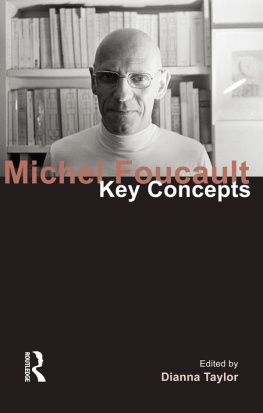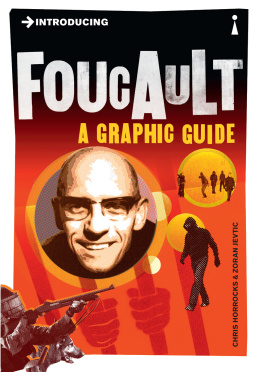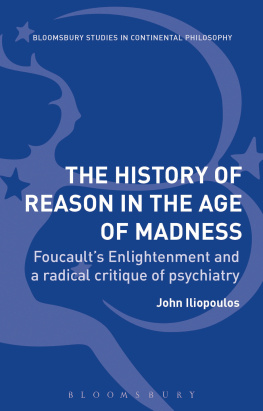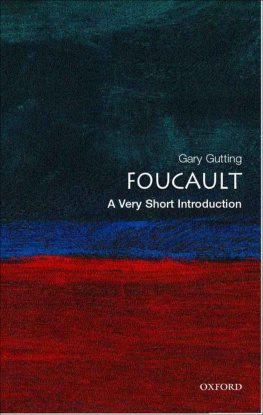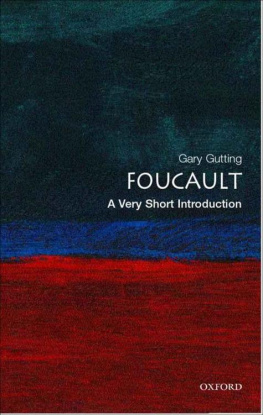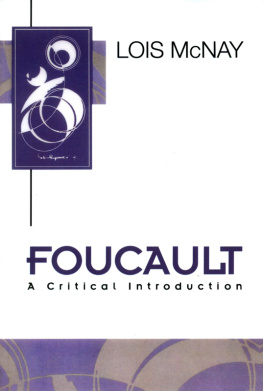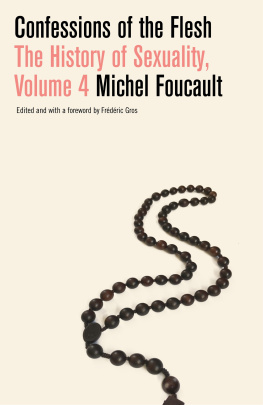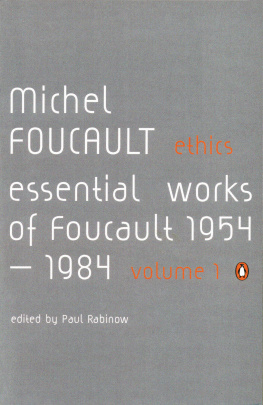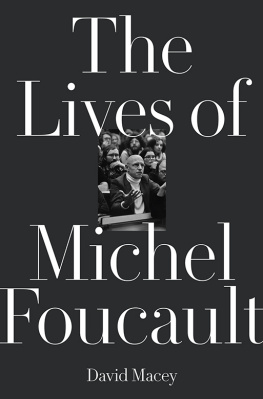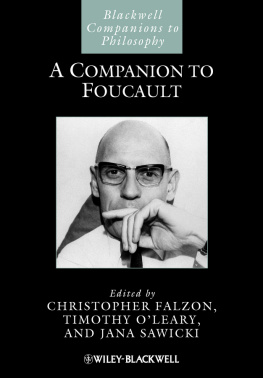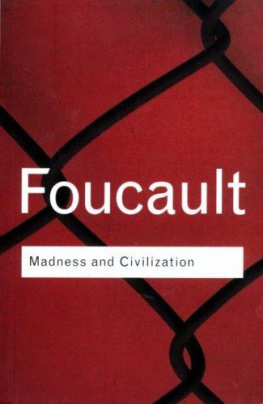Titles in the series Critical Lives present the work of leading cultural figures of the modern period. Each book explores the life of the artist, writer, philosopher or architect in question and relates it to their major works.
In the same series
Jean Genet
Stephen Barber
Pablo Picasso
Mary Ann Caws
Michel Foucault
David Macey
Michel Foucault
David Macey

REAKTION BOOKS
For you, Margaret
Published by Reaktion Books Ltd
33 Great Sutton Street
London EC1V 0DX
www.reaktionbooks.co.uk
First published 2004
Copyright David Macey 2004
All rights reserved
No part of this publication may be reproduced, stored in a retrieval system, or transmitted, in any form or by any means, electronic, mechanical, photocopying, recording or otherwise, without the prior permission of the publishers.
Page references in the Photo Acknowledgements and Index match the printed edition of this book.
Printed and bound by Biddles Ltd, Kingss Lynn
British Library Cataloguing in Publication Data
Macey, David, 1949
Michel Foucault. (Critical lives)
1. Foucault, Michel 2. Philosophers France Biography
I. Title
194
ISBN 1 86189 226 8
Contents

One
There is a rue du Dr Foucault in the centre of Nanterre. The street was named in honour of Paul Foucault, a nineteenth-century physician who devoted his life to caring for the poor of what was still an agricultural village and not yet a suburb of Paris. Almost nothing is known about him except that he died penniless, as befits a doctor who treated his patients at little or no cost. The only thing he bequeathed to his family was a silver pen presented to him by a delegation of grateful patients. It remained in the family for three generations but was eventually stolen during a burglary and has never been recovered. The victim of the burglary was Denys Foucault, the younger brother of Paul-Michel Foucault.
Michel Foucault and his siblings were not children of Paris and its suburbs. They were born into a wealthy provincial family living in Poitiers, some 300 kilometres to the south-west of the capital. Born in 1900, Foucaults mother, Anne Malapert, was the daughter of a surgeon and anatomist who taught at the citys medical school. Her family was rich and well connected. Her cousin Jean Plattard had taught at the local university before being appointed to a post at the Sorbonne in Paris, where he won a solid reputation for his scholarly editions of Rabelais, Montaigne and other Renaissance authors. Her brother Paulin taught philosophy at a Paris lyce. He held a doctorate and was the author of a well-respected philosophy textbook published in 1907. Her brother Roger opted for a military career, rose to the rank of colonel, and fought with great distinction during the First World War. Her family owned land and a large house known as Le Piroir in the village of Vendeuvre-du-Poitiers, 18 kilometres outside Poitiers. The house still stands in its own grounds at the end of a long drive lined with lime trees. Impressive rather than conventionally beautiful, it is built from the local limestone, which is porous, and therefore had problems with damp. By the time that Anne was born, her family had accumulated sufficient wealth to build a large white house at 10 rue Arthur Ranc in the centre of Poitiers. It was here that Paul-Michel Foucault was born on 15 October 1926. He was the second of three children.

A general view of Poitiers, the setting for a provincial childhood.
In 1924 Anne Malapert married Paul-Andr Foucault, who was seven years older than she. Born in Fontainebleau, he was, like his father and grandfather before him, a doctor. He had served in the army during the Great War and had been awarded the Croix de guerre. After moving to Poitiers, he worked at the Htel-Dieu hospital, where he acquired a good reputation as an anatomist, and had a private surgical practice. The Foucault and Malapert practices eventually merged and prospered. The new practice extended far beyond Poitiers itself and covered a wide rural area. Dr Foucault and his wife had contacts, both professional and personal, with the Benedictine community at St Martins Abbey in nearby Ligug. The size of the practice meant that Dr Foucault worked long hours and was often away from home; the state of medical technology was such that a folding operating table had to be carried in the boot of one of the two cars he ran. When necessary, his driver doubled as an anaesthetist.
The Foucault family was by no means aristocratic, but both Foucaults father and mother were local notables and respected citizens. Their wealth derived from the classic combination of fees from a liberal profession and land-owning. All that was needed to complete the picture of provincial prosperity was a lawyer in the family. By the 1930s they could afford to purchase a holiday home in La Baule on the Atlantic coast. The town, with its broad sweep of sand and its pines, is now a rather exclusive and expensive resort; in the 1930s it was relatively undeveloped, although it already had a casino, and was frequented mainly by middle-class families from Nantes and Saint-Nazaire.
Foucaults mother would have liked to become a doctor, but convention was against her: women of her class and background did not work. Her considerable energies were therefore invested in her family. She ran the household and its servants single-handed and, with the help of a secretary, effectively managed the practice. This was important: a doctor was a businessman as well as a physician. She also took sole responsibility for the care of her children. Both she and her husband were very ambitious for their children, and quite prepared to exploit their numerous family and professional connections on their behalf.
Paul-Michel Foucault was the child of a family that enjoyed both social prestige and social power. The house in the rue Arthur Ranc was spacious enough for each of the three children to have their own bedroom. There was a garden, and cats and dogs were in permanent residence. The family was respectable, politically conservative and church-going in a fairly conventional fashion, though it was usually their grandmother who took the children to Sunday mass at Saint-Porchaire in the city centre. Paul-Michel was also the child of a family with a strong sense of tradition. Eldest sons were always called Paul, usually with a second hyphenated forename the Michel was his mothers idea. And they became doctors and surgeons.
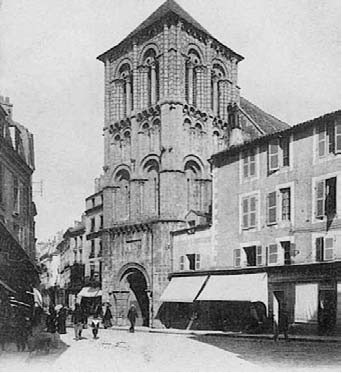
St Porchaire, Poitiers: Mass on Sundays.
The capital of the Vienne dpartement, Poitiers, stands on a rocky promontory at the confluence of the rivers Clain and Boivre. In the mid-1920s it had a population of just over 40,000, virtually no industry and was dependent for its wealth on its rich agricultural hinterland. Many found the town to be introverted and indifferent or even hostile to outsiders. Some had the impression that nothing had happened there for hundreds of years. The citys rich heritage and particularly the faades of its many Romanesque churches bore witness to a glorious past, but it was now little more than a sleepy provincial backwater. Its medieval streets and alleys were not yet the tourist attraction they have become. The medical school taught only the first three years of the traditional degree, and students then had to transfer elsewhere to complete their course.



